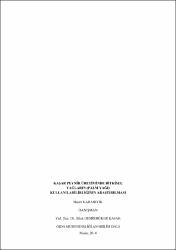| dc.contributor.advisor | Demirbüker Kavak, Dilek | |
| dc.contributor.author | Karabıyık, Hacer | |
| dc.date.accessioned | 2019-05-28T12:37:34Z | |
| dc.date.available | 2019-05-28T12:37:34Z | |
| dc.date.issued | 2013 | |
| dc.identifier.uri | http://hdl.handle.net/11630/6244 | |
| dc.description.abstract | Bu çalışmanın amacı kaşar peynir üretiminde bitkisel yağlardan palm yağının kullanılabilirliğinin araştırılması ve doğal/legal yolla üretilen kaşar ile tağşişli üretilen kaşarlar arasındaki temel fizikokimyasal, yapısal ve duyusal farklılıkların belirlenmesidir. Çalışmada üç farklı formülasyonda palm yağı içeren kaşar peyniri üretilmiş ve 90 gün süreyle depolanmıştır. Peynirlerin depolama süresince yağ, kuru madde, tuz, pH ve titrasyon asitliği analizleri, tekstür profil analizi (TPA), renk ve duyusal analizleri yapılmıştır. Ayrıca üretilen peynirlerde bitkisel yağ miktarının belirleyicisi olan β-sitosterol, gaz kromatografisi ile analizlenmiştir. Sonuçlarda, β-sitosterol miktarı tespit edilebilir düzeyde bulunmuştur. Depolama boyunca hiçbir peynir grubunda yağ ayrılması tespit edilmemiştir. Depolama süresinin tekstür üzerinde önemli etkisi olduğu saptanmıştır. Farklı formülasyondaki peynirlerde duyusal açıdan belirgin bir fark gözlenmemiştir. Sonuç olarak, bitkisel yağ ilaveli olmasına karşın temel kalite kriterleri bakımından gıda standartlarına uygun kaşar peyniri üretilebilmiştir. | en_US |
| dc.description.abstract | The aim of this study is to investigate the usage of palm oil as vegetable oil in kashar cheese production and to determine the basic physicochemical, textural and sensory differences between naturally/legally produced kashars and adultrated kashars. In this study, kashar cheese containing palm oil was produced with three different formulations and stored for 90 days. During storage of kashar cheese, fat, dry matter, salt, pH, titratable acidity, texture profile analysis (TPA), colour and sensory analysis were conducted. Additionally, β-sitosterol content was analzyed which is a marker of vagatable addition in kashar cheese. Results showed that β-sitosterol content was in the detectable range. No oil seperation was detected in the cheese groups during the storage period. There was not significant difference in sensory evaluations of cheeses produced with different formulations. In conclusion, despite of containing vegetable oil, kashar cheeses meeting food standards in terms of basic quality criteria were produced. | |
| dc.language.iso | tur | en_US |
| dc.rights | info:eu-repo/semantics/openAccess | en_US |
| dc.subject | Kaşar Peyniri | en_US |
| dc.subject | β-Sitosterol | |
| dc.subject | Tağşiş | |
| dc.subject | Palm Yağı | |
| dc.title | Kaşar peynir üretiminde bitkisel yağların (palm yağı) kullanılabilirliğinin araştırılması | en_US |
| dc.title.alternative | Investıgatıon of vegetable oil (palm oil) use in kashar cheese production | en_US |
| dc.type | masterThesis | en_US |
| dc.department | Afyon Kocatepe Üniversitesi, Fen Bilimleri Enstitüsü | en_US |
| dc.identifier.startpage | 1 | en_US |
| dc.identifier.endpage | 53 | en_US |
| dc.relation.publicationcategory | Tez | en_US |



















